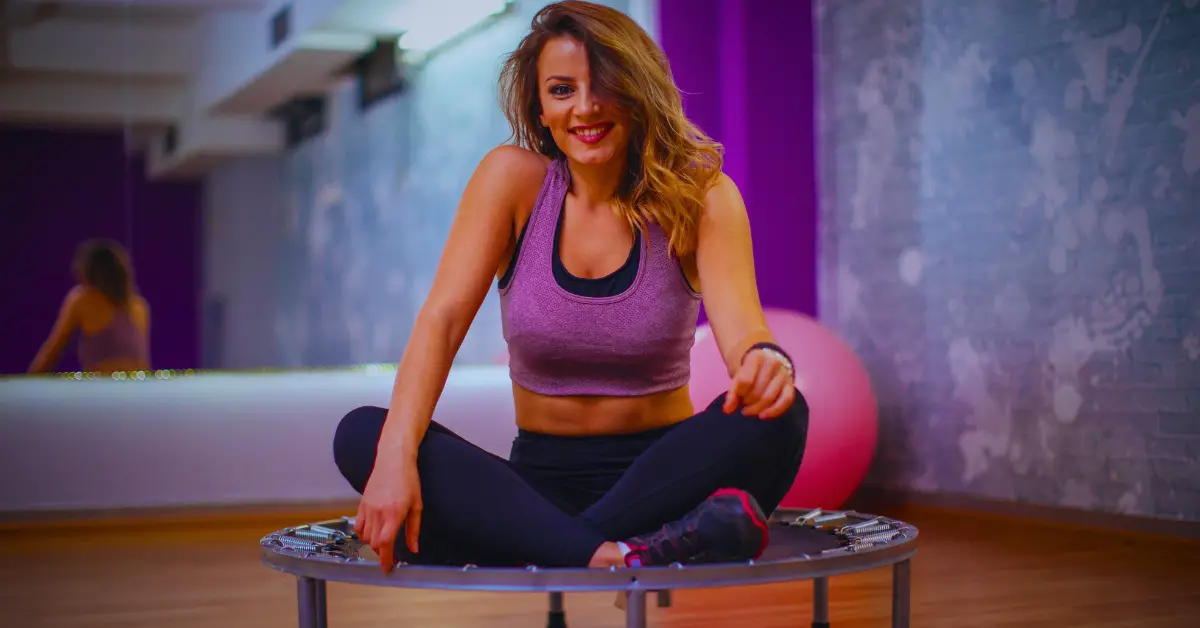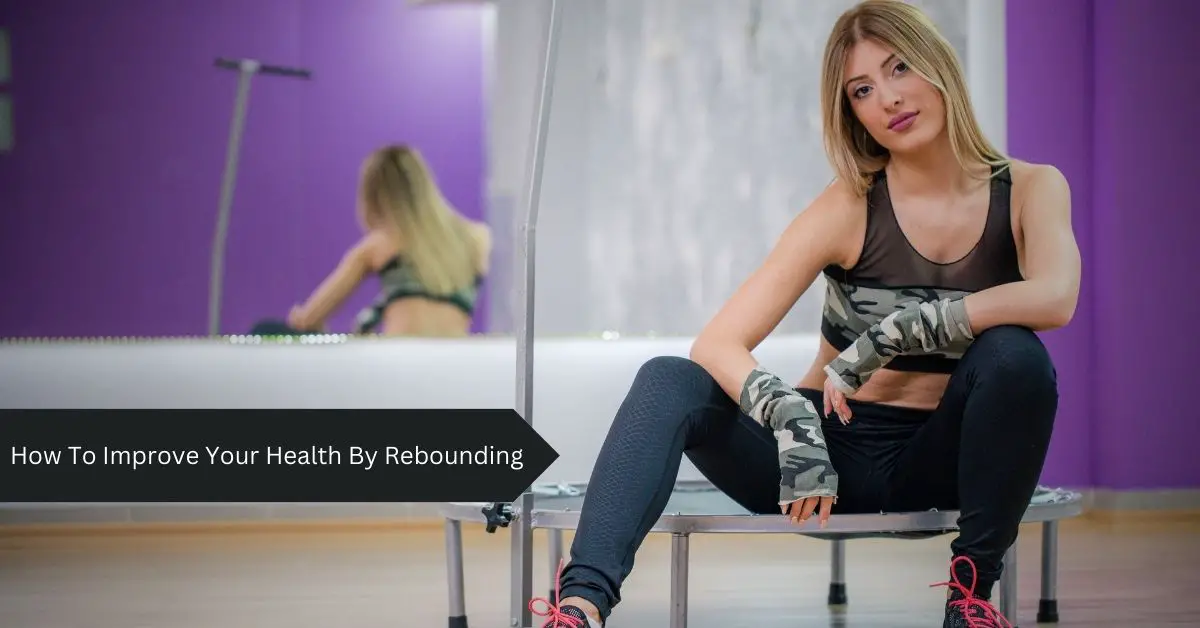Discover the secret to boosting your health and fitness with rebounding. Learn how this fun exercise can transform your well-being in no time!
Are you looking for an effective and fun way to improve your health? Look no further than rebounding!
Rebounding, also known as mini-trampoline workouts, is a fantastic exercise that offers a multitude of benefits for your overall well-being.
Incorporating this low-impact activity into your fitness routine can boost cardiovascular health, shed unwanted pounds, tone muscles, enhance lymphatic system function, relieve stress, improve mental well-being, and even enhance balance and coordination.
The best part? Rebounding is suitable for people of all ages and fitness levels. Whether you’re a beginner or an experienced athlete, rebounding can be easily integrated into your daily life.
In this article, we’ll explore how rebounding can benefit your health and provide tips on how to get started with this enjoyable exercise. Get ready to bounce back into better health!
How To Improve Your Health By Rebounding: Rebounding, a low-impact exercise performed on a mini trampoline, offers numerous health benefits. Regular rebounding sessions can enhance cardiovascular health, strengthen muscles, improve balance, stimulate lymphatic flow, and boost overall well-being. Incorporate this fun and effective workout into your routine for better health.
Understanding the Benefits of Rebounding
You’re probably wondering how rebounding can benefit your health and improve your well-being. Well, let me tell you, rebounding has numerous benefits that can do wonders for your body.
Firstly, it’s great for bone health. When you jump on a trampoline or a rebounder, the impact of landing stimulates bone cells to become stronger and denser. This helps prevent conditions like osteoporosis and keeps your bones healthy and strong.
Secondly, rebounding is fantastic for improving digestion. The bouncing motion helps stimulate the lymphatic system, which is responsible for removing toxins from the body and aiding in digestion.
So not only will rebounding help you feel lighter and more energized, but it also promotes better digestive health.
Start incorporating rebounding into your routine today to reap all these fantastic benefits!
What are the Steps to Begin Rebounding?
Rebounding is a simple and gentle activity that involves bouncing on a small trampoline called a rebounder. To get started, it’s recommended to bounce for at least 15 minutes a day, which can be broken into shorter sessions of 3-5 minutes each.
When you begin, keep your feet on the rebounder and start with gentle jumps. As you get more comfortable, you can try lifting your feet off the rebounder while jumping.
For example, you can add rebounding to your daily routine by bouncing on the rebounder for a few minutes when you wake up. Some people like to do it before or after dry brushing their skin, as it may help with avoiding cellulite.
You can also take short rebounding breaks throughout the day, especially if you keep the rebounder in a convenient place like your bedroom.
There are various rebounder models to choose from, ranging in price. While more expensive ones may have better springs to reduce the impact on joints, even the cheaper options can work well.
Some popular rebounders include the Needak Rebounder, Jump Sport Rebounder, and Stamina 36-inch Rebounder. Pick one that suits your preferences and budget!
How Rebounding Improves Cardiovascular Health
Boosting your cardiovascular fitness becomes easier with rebounding, as it helps to strengthen your heart and improve blood circulation. Rebounding is a low-impact exercise that involves jumping on a mini trampoline, which increases your heart rate and improves endurance.
This exercise also helps increase oxygen uptake, allowing muscles to work more efficiently. When you rebound, the up-and-down motion engages significant muscle groups in your legs, buttocks, and core. This repetitive movement strengthens these muscles and increases blood flow throughout your body.
As a result, your heart has to work harder to pump oxygen-rich blood to all parts of your body. Regular rebounding sessions can lead to significant improvements in cardiovascular health.
Incorporating this fun and effective exercise into your routine can enhance your heart’s strength and efficiency while increasing overall endurance and oxygen uptake.
So start bouncing today for a healthier heart!
Rebounding for Weight Loss and Muscle Tone

Rebounding workouts can help you shed weight and sculpt your muscles, creating a leaner and more toned physique. Rebounding is an effective exercise that combines cardiovascular benefits with muscle-strengthening techniques.
You engage multiple muscle groups, including your core, legs, and arms, by jumping on a mini trampoline or using a rebounder. This high-intensity workout helps to burn calories and increase your metabolism, leading to weight loss.
Additionally, the constant bouncing motion stimulates lymphatic drainage, which aids in detoxification and reduces cellulite. Rebounding also improves bone density and joint strength while reducing the risk of injury compared to other high-impact exercises.
Incorporating rebounding into your fitness routine provides a fun and efficient way to achieve your weight loss goals while toning and sculpting your muscles for a healthier body overall.
Boosting Lymphatic System Function with Rebounding
When achieving optimal wellness, there’s nothing like incorporating rebounding into your fitness routine. Rebounding not only helps with weight loss and muscle tone, but it also has incredible benefits for boosting your lymphatic system function.
Here are four reasons why rebounding is excellent for promoting your immune system and detoxification:
- Increased circulation: The up-and-down motion of rebounding helps to stimulate the flow of lymph fluid throughout your body, improving the transport of nutrients and oxygen to cells while removing waste products.
- Lymphatic drainage: Rebounding helps to flush out toxins from your lymphatic system, promoting a healthier immune response and reducing the risk of illness.
- Enhanced detoxification: By jumping on a mini-trampoline, you can facilitate the elimination of toxins through sweating, supporting your body’s natural detoxification process.
- Strengthened immune system: Regular rebounding can increase the production of white blood cells, which play a crucial role in defending against infections and diseases.
Incorporating rebounding into your fitness routine is a fun and effective way to boost your immune system and enjoy its detoxification benefits. So grab a mini-trampoline and start bouncing towards better health today!
Rebounding for Stress Relief and Mental Well-being
Rebounding on a mini-trampoline is a fantastic way to relieve stress and improve your mental well-being. Not only does it provide physical benefits, but it also has positive effects on your mental health.
When you rebound, your body releases endorphins, natural mood enhancers that can help you relax and feel happier. It’s like a natural stress buster!
Rebounding also helps increase blood flow to the brain, promoting mental clarity and focus. As you bounce up and down, you can let go of all the worries and tensions of the day.
The rhythmic motion of rebounding can be meditative, allowing you to clear your mind and find inner peace. So if you’re looking for a fun and effective way to reduce stress and boost your mental well-being, give rebounding a try!
Rebounding for Improved Balance and Coordination
Boost your balance and coordination with the exciting benefits of rebounding on a mini-trampoline! Rebounding isn’t just a fun way to stay fit; it can also improve your agility and athletic performance.
When you bounce on a mini-trampoline, your body constantly adjusts to the changing surface beneath you. This helps strengthen the muscles in your legs, core, and back.
Over time, this constant adjustment improves your balance, making everyday activities easier and reducing the risk of falls or injuries.
In addition to balance, rebounding requires coordination as you control your bouncing movements. Regular rebounding sessions can help sharpen your reflexes and hand-eye coordination.
So why not add a mini-trampoline to your fitness routine? You’ll have a blast while reaping all these fantastic benefits for your balance and coordination!
Incorporating Rebounding into Your Fitness Routine

To enhance your fitness routine, consider integrating rebounding on a mini-trampoline as it can contribute to better balance and coordination. Rebounding is a low-impact exercise that provides numerous benefits for overall health.
Here are four ways you can incorporate rebounding into your fitness routine:
- Start with a warm-up: Begin your session by gently bouncing on the trampoline for a few minutes to warm up your muscles and get your blood flowing.
- Try interval training: Alternate between high-intensity jumps and periods of rest to challenge yourself and improve cardiovascular endurance.
- Use resistance bands: Incorporate resistance bands into your rebounding workouts to engage more muscle groups and increase the intensity of your exercises.
- Explore different exercises: From basic jumps to twists, kicks, or even dance routines, there are endless possibilities with rebounding equipment. Keep it fun, and experiment with different movements to target various areas of your body.
By incorporating rebounding into your routine, you’ll boost balance and coordination and enjoy an effective full-body workout that promotes overall health.
Choosing the Right Rebounder and Safety Considerations
Now that you understand the benefits of incorporating rebounding into your fitness routine let’s dive into choosing the right rebounder and some important safety considerations. Selecting the right rebounder is crucial to ensure maximum effectiveness and reduce the risk of injury.
Consider durability, bounce quality, and weight capacity when choosing a rebounder. Look for a model that suits your specific needs and preferences, whether a mini-trampoline or a full-sized one.
Additionally, don’t forget about safety! Always use proper form while bouncing, and start with shorter sessions to allow your body to adjust gradually. It’s also essential to clear your workout area from any hazards or obstacles that could cause accidents.
By taking these precautions, you can enjoy all the health benefits of rebounding while minimizing any potential risks.
| Choosing the Right Rebounder | Safety Considerations |
|---|---|
| Durability | Proper Form |
| Bounce Quality | Gradual Progression |
| Weight Capacity | Clear Workout Area |
Tips for Getting Started with Rebounding
Get ready to experience a new fitness level as you embark on your rebounding journey, and let these tips help you make the most out of it. Rebounding is an excellent way to improve your health and get in shape, especially starting.
Here are some helpful tips for getting started with rebounding:
- Start slow: Begin with short sessions and gradually increase your time on the rebounder.
- Warm-up: Before jumping on the trampoline to prevent injuries.
- Proper form: Maintain appropriate posture and engage your core muscles while rebounding.
- Mix it up: Add variety to your workouts by incorporating exercises like jumping jacks or squats.
- Stay hydrated: Drink plenty of water before, during, and after your rebounding sessions.
By following these tips, you’ll have a beginner’s guide to successful rebounding and be well on your way to improving your health and fitness levels. So, lace up those shoes, step onto the trampoline, and prepare for an exhilarating workout that energizes you.
Listening to Your Body and Seeking Professional Advice
Listening to Your Body and seeking professional advice are two essential aspects when engaging in any form of exercise or physical activity. Here’s why they are important:
Listening to Your Body:
- Paying Attention: Being mindful of how your body feels during and after exercise helps you understand its limitations and needs.
- Avoiding Overexertion: Recognizing signs of fatigue, pain, or discomfort allows you to avoid pushing yourself too hard, reducing the risk of injuries.
- Customizing Workouts: By understanding your body’s responses, you can tailor workouts to your fitness level and gradually progress as you become more comfortable.
Seeking Professional Advice:
- Ensuring Safety: Consulting with healthcare professionals, such as doctors or physical therapists, helps identify any underlying health conditions that may affect your exercise routine.
- Personalized Guidance: Working with certified fitness trainers allows you to create a workout plan suited to your specific goals and physical abilities.
- Nutrition and Health Support: Nutritionists and dietitians can provide advice on dietary choices that complement your exercise regimen, promoting overall well-being.
Open Communication:
- Sharing Concerns: Being open and honest with professionals about your health status and objectives enables them to provide the best advice and support.
- Progress Updates: Keeping professionals informed about your progress helps them assess the effectiveness of your current plan and make necessary adjustments.
Knowing When to Stop:
- Prioritizing Safety: Recognizing the warning signs, such as severe pain or dizziness, prompts you to stop exercising immediately and seek appropriate medical attention if needed.
Continual Learning and Adaptation:
- Staying Informed: Keeping abreast of the latest information and safety guidelines ensures that you can make informed decisions about your exercise routine.
- Embracing Change: Being open to modifying your workouts based on professional advice and your body’s responses allows for continued progress and improvement.
In conclusion, listening to your body and seeking professional advice is essential for a safe and effective exercise journey. By being attentive to your body’s signals and seeking guidance from qualified experts, you can make the most of your workouts, achieve your fitness goals, and maintain overall health and well-being.
Related Article: Health Benefits of Rebounding
Frequently Asked Questions For How To Improve Your Health By Rebounding:
Q.1 Can rebounding help improve digestion and alleviate digestive issues?
Yes, rebounding can help improve digestion and alleviate digestive issues. Bouncing on a mini trampoline stimulates the lymphatic system, aiding in detoxification and improving overall gut health. Rebounding is also effective for weight loss.
Q.2 Is rebounding a suitable exercise for pregnant women?
Rebounding can be a suitable exercise for pregnant women. It is low-impact, gentle on joints, and helps improve cardiovascular fitness. However, it’s essential to consult with your healthcare provider before starting any exercise routine during pregnancy.
Q.3 Can rebounding help improve posture and alleviate back pain?
Rebounding can indeed help improve posture and alleviate back pain. By engaging your core muscles and promoting spinal alignment, rebounding strengthens the muscles that support your spine and helps improve balance. It also increases lymphatic drainage, aiding in detoxification.
Q.4 Are any specific rebounding exercises targeting the abs and core muscles?
Yes, specific rebounding exercises target your abs and core muscles. These exercises can help you lose weight while improving your cardiovascular health. Incorporating these exercises into your routine will positively impact your overall fitness.
Q.5 Can rebound help improve flexibility and joint mobility?
Rebounding can help improve flexibility and joint mobility, enhancing your overall health. It strengthens muscles, increases cardiovascular endurance, and improves balance. Enjoy the benefits of rebounding as you work towards a healthier you!
Conclusion:
In conclusion, rebounding is a fun and effective way to improve your health. By incorporating this low-impact exercise into your fitness routine, you can enjoy numerous benefits such as improved cardiovascular health, weight loss, muscle tone, boosted lymphatic system function, stress relief, mental well-being, and improved balance and coordination.
Remember to choose the right rebounder for your needs and always prioritize safety. So why wait? Start rebounding today and take control of your health in a fun and rewarding way!
After reading this extensive guide on How to improve your health by rebounding, we trust you will gain a thorough understanding. Should you have any inquiries, please don’t hesitate to comment below.

